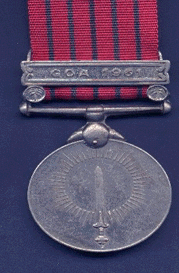Awards
General Service Medal
Period : 5 June 1950The individual active service events are each represented by a bar, and these are detailed below. Multiple bars are, of course, possible. In practice, however, they seem to be quite uncommon. All bars observed have been inscribed in English, rather than in Hindi. Throughout, and regardless of the specified time periods for qualification decoration, wounds resulting in evacuation, or death in circumstances of active service result in automatic eligibility for the medal and appropriate bar. Likewise, time spent as a prisoner-of-war is allowed to count toward the qualifying period. In 1965, the medal was superceded by the Samanya Seva Medal. Established: 5 June 1950, by the President of India (with effect from 15 August 1947). The reverse designs were altered by Presidential amendments of 26 June 1954 and 6 December 1954. Obverse: A circular copper-nickel medal, with the Bhavani, or divine sword of justice and true discrimination, point upward and within a halo. Suspended by a non-swiveling straight-bar suspender to which the bar is attached. These bars (except that for "Mizo Hills") are distinguished by having individualized representative emblems at each end; these are detailed below. The medals are usually named on the edge with impressed capital letters. Reverse: The original design of 1950, which was never issued, described the reverse: in the center, a lotus flower with buds with the legend above "The General Service Medal" and, below, "1947". In June 1954, the lower reverse legends were altered to read "1947" with "INDIA" just above this. Finally, in December 1954, the design of the reverse as actually issued was specified as having the upper inscription read "GENERAL SERVICE" and, below, "INDIA". No specimens have been seen of the first two reverses, though prototypes may exist. Ribbon: 31 mm, red with five 1-mm dark green stripes. Red 5 mm, dark green 1 mm, red 4 mm, dark green 1 mm, red 4 mm, dark green 1 mm, red 4 mm, dark green 1 mm, red 4 mm, dark green 1 mm, red 5 mm. As it has been so common and so widely produced, there is some variability of the precise shades of the colors in this ribbon. These color variations have no significance (as some have stated).
Outline:
second reverse (1954), "The General Service Medal" above and "India / 1947" below - never issued except as prototypes?
Overseas Korea 1950-53 - instituted on 5 June 1950 (as one of the original bars for the medal), this clasp was awarded for one day of service ashore in Korea between 22 November 1952 and 8 July 1953 on the active strength of the 60th Para Field Ambulance Unit - the bar has a caduceus ascending from a lotus flower at the ends .
Naga Hills (1955-56) - instituted in 1960 - ??? - awarded for 180 days (90 days for temporary inductees) of operational service in the Naga Hills or Tuensang area of northeastern India between 27 April 1955 and ??? 1956 - air force personnel would qualify through five operational sorties of twenty hours of operational flying during this period and in this area - service in Operation "Orchid" (???) was to be counted only toward the "Mizo Hills" bar to the General Service Medal - later service would be recognized by the "Nagaland" bar to the Samanya Seva Medal, 1965 - the bar has bamboo at the ends.
Goa 1961 - instituted on 22 December 1962, this clasp was awarded for services in the reunification with India of the remnant Portuguese colonies along India's coast - this bar was awarded for two days (48 hours) of actual service within the geographical limits of Goa, Daman and Diu from 18 to 22 December 1961 - air force personnel would qualify through one operational sortie during this period - the bar has a palm tree at the ends.
Ladakh 1962 - instituted on 23 June 1965 for services against Chinese forces in Ladakh, along India's northern borders - the specific areas and conditions of service were quite detailed (down to the citation of specific map coordinates) but, in brief, the bar was awarded for one day of service in (1) the battle surrounding Yula 20-23 October 1962, (2) the battles along the southern border of Ladakh 27-29 October 1962, or (3) the battle at Chushul 18-21 November 1962 - the bar could also be awarded for fifteen days of service within Ladakh between 20 October 1962 and 21 November 1962 - air force personnel would qualify through one operational sortie in these specific battles, three operational sorties elsewhere in the area, of twelve hours of flying in the area during this period - the bar has mountains at the ends.
Mizo Hills (1966-75) - instituted on 16 July 1970, with effect from 28 February 1966 for 180 days (90 days for temporary inductees) of service Operation "Orchid" (???) or in north-eastern India in the Mizo Hills area, in Chachar or in Tripura - service in Operation "Orchid" could not be counted toward the "Naga Hills" bar to the General Service Medal and general area service in the Mizo Hills region could not count toward the "Bengal-Assam" bar to the Sainya Seva Medal - the actual areas of qualifying service are defined in truly excruciating detail, including map coordinates, and are not included here - later service would be recognized by the "Mizoram" bar to the Samanya Seva Medal, 1965 - the bar has uniquely plain ends | Other CategoriesGeneral Service MedalMain CategoriesParam Vir ChakraAshoka Chakra Maha Vir Chakra Kirti Chakra Sarvottam Jeevan Raksha Padak Ati Vishisht Seva Medal Vir Chakra Shaurya Chakra President's Police and Fire Services Medal for Gallantry Sena Medal |
